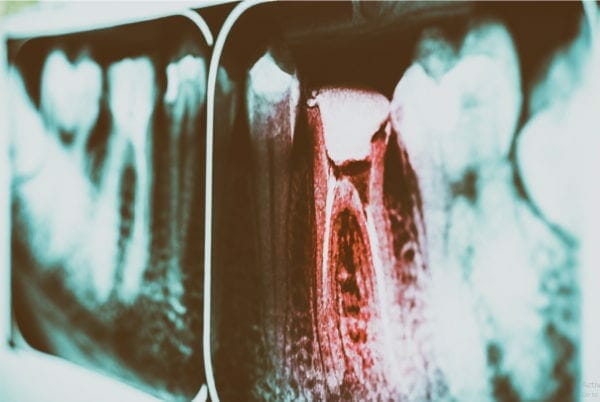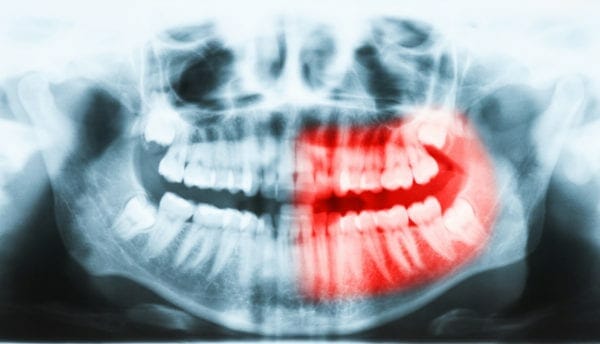What Is An Impacted Tooth?
The typical adult mouth has 32 teeth—8 incisors, 4 canines, 8 premolars, 8 molars, and 4 wisdom teeth (also called third molars). Each type of tooth has a distinct function and location. Impacted teeth can happen for many reasons.
- Incisors (the middle front teeth) cut food into small pieces.
- Canines (the pointed teeth next to the incisors) grip and tear food.
- Premolars (located between canines and molars) crush and tear food.
- Molars (flat teeth at the rear of the mouth) grind food.
If a tooth doesn’t grow in as expected, it is called an impaction. The impacted teeth definition is “any tooth that is prevented from reaching its normal position in the mouth by tissue, bone, or another tooth.” Impactions can be complete (not visible) or partial (part of the tooth is visible).
 Although any tooth can become impacted, the two most commonly affected are wisdom teeth and canine teeth. Because these teeth have different functions and locations, impactions are treated differently. Wisdom teeth are usually extracted, while canine teeth are usually directed or moved into the correct position by an orthodontist.
Although any tooth can become impacted, the two most commonly affected are wisdom teeth and canine teeth. Because these teeth have different functions and locations, impactions are treated differently. Wisdom teeth are usually extracted, while canine teeth are usually directed or moved into the correct position by an orthodontist.
At Burke & Redford Orthodontists, we specialize in treatment to help prevent and manage impacted teeth. Dr. Redford and Dr. Burke play a key role in the treatment of impacted canines, which involves extensive orthodontic treatment.
Causes of Impacted Teeth
There are two primary types of impacted teeth. One being a tooth that doesn’t erupt (break through the gum) when expected. The second is when a tooth can’t erupt because it doesn’t have enough room or is growing in the wrong direction.
Patients may have impacted teeth or a tooth for a wide variety of reasons, including:
- Genetic predisposition
- Not enough space in the mouth
- Something is blocking the tooth’s path
- Slow development of the tooth
- Tooth shape
Teeth can also become tilted or twisted when emerging, which leads to different types of impactions.
- Horizontal impacted tooth – a tooth grows in sideways beneath the gums and into the roots of the tooth next to it. This is a serious type of impaction because of the high potential for damage to adjacent tooth roots. Surprisingly enough, this can often be asymptomatic.
- Vertical impacted tooth – a tooth grows vertically but does not erupt through the bone or tissue.
- Angular impacted tooth – teeth are angled toward the front (mesial impaction) or back (distal impaction) of the mouth. Distal impactions are rare, and treatment depends on the situation. Mesial impactions are more common.
With any impaction, it is extremely important that a thorough exam be performed to rule out damage to adjacent tooth roots. Damage often occurs without any associated pain or discomfort!
Impacted Tooth Symptoms and Diagnosis
Many patients with impactions are asymptomatic (have no symptoms). However, patients experiencing the following symptoms should be checked by an orthodontist or dentist.
- Red, swollen, or painful gums (especially in the back of the mouth)
- Bad breath or an unpleasant taste in the mouth
- Difficulty or pain when opening the jaw
- Pain when chewing and biting
Because impactions usually take place below the gumline, the main diagnostic tool are dental x-rays. If untreated, an impacted tooth can lead to root resorption (damage or permanent wearing away) of adjacent, otherwise healthy tooth roots. Tooth decay, infection, gum disease, and cysts are other associated risks.
Impactions first become evident when children transition from their baby teeth into their adult teeth. For this reason, The American Association of Orthodontists recommends a screening x-ray and dental exam for all children around the age of 7. This allows dentists to localized the teeth and determine if there are problems with the eruption of adult teeth.
Impacted canine teeth usually become apparent between the ages of 8 to 14. By contrast, wisdom teeth typically don’t erupt until the late teens and early adulthood (ages 17 to 21).
What Are Impacted Canines?
 As mentioned previously, canine teeth (also known as eye teeth, cuspids, or fangs) are the second most common teeth that can become impacted. Being one of the last teeth to erupt (usually between the ages of 10 to 12), as well as having the longest and most torturous pathway to eruption makes these teeth susceptible to getting stuck. Lack of adequate space can also play a role in canines becoming impacted. It is also interesting to note that canine impactions happen two to three times more frequently in females than males.
As mentioned previously, canine teeth (also known as eye teeth, cuspids, or fangs) are the second most common teeth that can become impacted. Being one of the last teeth to erupt (usually between the ages of 10 to 12), as well as having the longest and most torturous pathway to eruption makes these teeth susceptible to getting stuck. Lack of adequate space can also play a role in canines becoming impacted. It is also interesting to note that canine impactions happen two to three times more frequently in females than males.
Early intervention is critical because canine teeth play an essential role in a person’s bite. They are the first teeth that touch when the jaw shifts side to side—guiding the rest of the teeth into a proper bite. The canines are also sharp, biting teeth with the longest roots of all human teeth. Because of their importance, every effort is made to get these teeth to erupt correctly.
If impacted canines aren’t treated early, several problems can occur.
- The impacted teeth or tooth can put pressure on neighboring tooth roots (usually the front teeth), which may damage their structure and compromise their longevity.
- If the baby canine falls out but the adult canine remains impacted, a patient has extra space and a less than ideal smile.
- A cyst may develop around the impaction—pushing nearby teeth out of position.
- When treatment is delayed into adulthood, the tooth might fuse to the surrounding bone. Once fusion occurs, the only remedy is extraction.
Treatment Options for Impacted Canines
The goal for impacted canine teeth is to encourage proper eruption. Treatment will depend on the type and severity of the impaction and its effect on the surrounding teeth.
- Creating Space. Because impacted canine teeth can sometimes be caused by overcrowding, the first step is to create space for them to erupt. This might involve extracting baby teeth or adult teeth that are blocking the canine. Another option is to use or expander appliances or space maintainers to open or save space. In some cases, braces are used to create or reorganize space. If space is opened and the eruption path cleared by the ages of 10-12, many canine teeth erupt on their own.
- Chain and Bracket Procedure. If an impacted canine threatens the health of an adjacent tooth, or if it simply isn’t erupting on its own, the orthodontist will direct an oral surgeon to perform and chain and bracket procedure. Before the procedure, braces are placed on several or all teeth. During the procedure, the gum on top of the impacted tooth is lifted to expose the tooth. An orthodontic bracket with a small gold chain is bonded to the tooth. The chain is then attached to an orthodontic arch wire. In most cases, the gum will be sutured—leaving only the chain exiting a small hole in the gum. After the surgery, the patient will return for continuing care with the orthodontist, who will “recover” the impacted canine. This is done by putting a light pulling force on the impacted human canine tooth. This force slowly and gently moves the tooth into its proper position. The length of this process depends on the severity of the impaction (location, angulation, position relative to other tooth roots) and how quickly the patient responds to orthodontic forces.
- If the buried tooth cannot be “recovered” – either because doing so may be risky/harmful to adjacent teeth or because it is fused to the surrounding bone, it may have to be removed. This is rare and only done as a last resort and after other options have been considered.
What Is An Impacted Wisdom Tooth?
Wisdom teeth are the last teeth to erupt (usually between the ages of 17 to 21). Also called third molars, wisdom teeth are the last teeth towards the back of the mouth. Because of their late eruption, they may not have enough room to grow correctly. If wisdom teeth don’t erupt at all (staying under the gum line) or don’t erupt normally, they are considered impacted.
Because these teeth rarely have a functional purpose, the standard treatment for impacted wisdom teeth is extraction. The American Dental Association recommends that all teenagers between the ages of 16 and 19 get their wisdom teeth evaluated by a dentist.
Many patients have these teeth at different stages—fully erupted, partially erupted, or fully impacted. When a wisdom tooth breaks through the gum tissue and part of it can be seen, this is called a partially impacted wisdom tooth. If the tooth never breaks through the gum, it is a fully impacted wisdom tooth.
Impacted Wisdom Tooth Extraction
If your orthodontist is concerned about impacted teeth, they will perform an x-ray. This impacted tooth or wisdom tooth x-ray will show the location of the wisdom teeth, if they are impacted, and if other teeth or bones are damaged. The most common solution is to extract the impacted teeth.
Impacted tooth removal is usually an outpatient procedure performed by an oral surgeon.
To learn more about how the most referred, best family orthodontists in Temecula at Burke & Redford Orthodontists can help you or your family with impacted teeth, call our office at (951) 699-8011 to schedule a free consultation. You can also fill out the form on our website, and our staff will contact you during business hours. We offer zero percent interest rate financing, too.